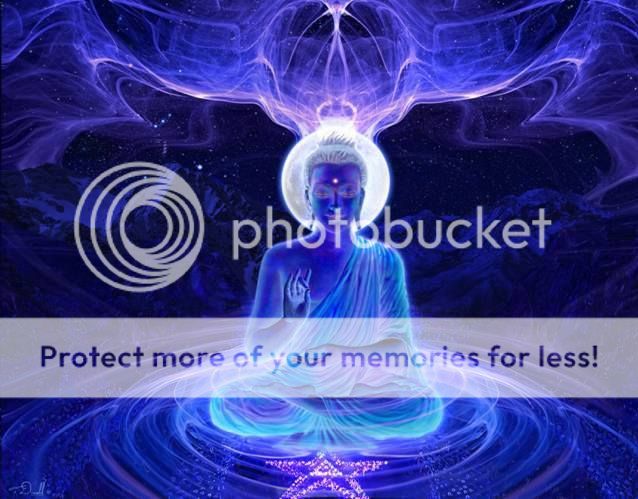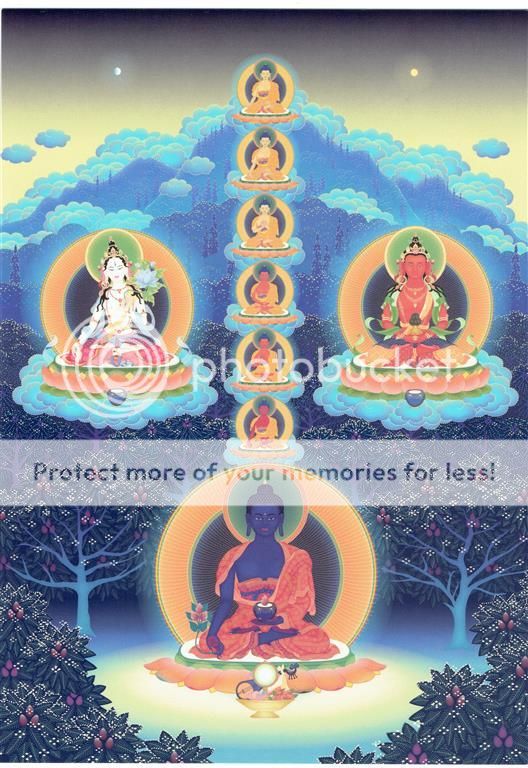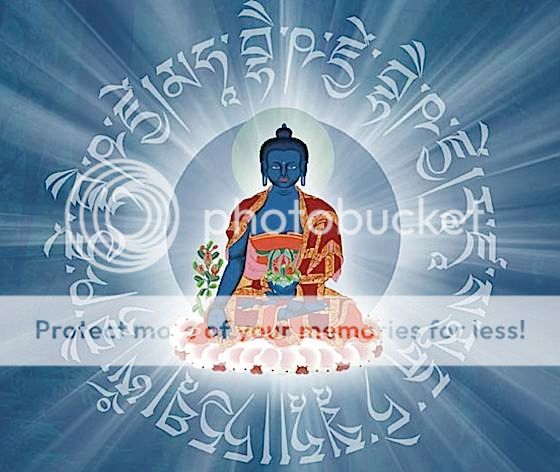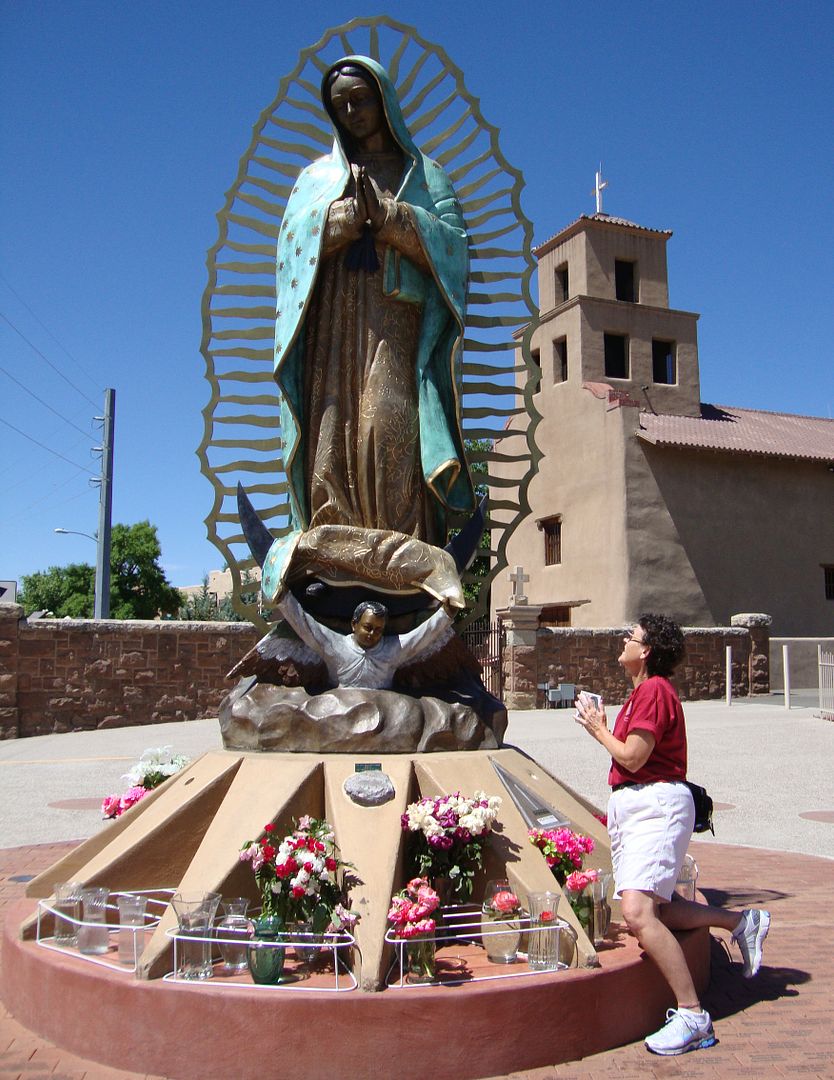The Blue Ray
I first learned about the Medicine Buddha when a Buddhist friend from California did a prayer meditation for my mother who was very ill. She said the Medicine Buddha is an enlightened
being known as the healer of physical and mental illness. He is depicted seated, wearing the three robes of a Buddhist monk, holding a blue-colored jar of medicine nectar in his left hand with the right hand resting on his right knee. He holds the stem of the Myrobalan plant which is considered an exceptional universal healing plant. A lapis lazuli blue aura surrounds him.
In the years that followed, my knowledge of the Medicine Buddha remained subtle and uninformed. But apparently that prayer she invoked for my mother was destined to sow seeds that would begin to emerge a few years later when my brother-in-law went to Nepal and brought me a beautiful Life of Buddha Thangka. It had all the aspects of Buddha, including the Medicine Buddha, painted on it. Soon after the painting was hung over our altar the Medicine Buddha began to make its presence known.
One morning in meditation two figures appeared on either side of the Medicine Buddha. The one on the left identified herself as the Bodhisattva Chandra, Goddess of the Moon. The one on the right identified herself as the Bodhisattva Surya, Goddess of the Sun. Both of them appeared in a sea of blue color. In the scene were shades of the most extraordinary clear blues with streams and pure rays of blue everywhere. I wrote down the meditation with plans to share it with our local women's circle, which I did in 2014.
Fast forward two years later. The local Buddhist Center invited the community to a Medicine Buddha Empowerment. An empowerment is like an initiation. It's a ceremonial ritual handed down in an unbroken lineage for thousands of years. It consists of prayers, blessings, a guided meditation, and an initiation into practices associated with a specific aspect of the Buddha.
Walking into the center my eyes fixed on a poster of the Medicine Buddha. Normally the Medicine Buddha, portrayed in blue, sits serenely alone. But this one was different. What caught my attention were the two deities on either side of the Buddha - the Goddess of the Moon and the Goddess of the Sun. I recalled the meditation from several years earlier as the bell rang for the ceremony.
An empowerment is a very singular and purposeful experience. No two are alike. After a series of teachings and chants the meditation guiding the empowerment began. In the stillness, the visuals that were called in took over my being. I became immersed inside a Blue Ray of light. Blue filled every cell in my body. I had no consciousness of anything but The Blue Ray. I felt blue, saw blue, and experienced blue. There was a notable collapsing of the physical entity into this absorption by The Blue Ray. It was like experiencing blocks slowly falling away until nothing but a Blue Ray remained. In that state, I was submerged into a vast healing space that was timelessly held by the being known as the Medicine Buddha. I had become the Blue Ray.
Since the empowerment the effects of the Blue Ray continue. When needed for healing, it's
summoned as though it never left. A cold, accompanied by 2 weeks of coughing, caused the muscles around my ribs to become painfully inflamed so I decided to visit my local physician. On a scale of 1-10, the pain was a 10. Before going to the doctor I summoned the Medicine Buddha in meditation. An hour after meditation I went to the doctor. When asked the level of pain, I said a 6. The doctor prescribed muscle relaxants and an anti-inflammatory medication. By the time I got home the pain was a 2. I filled NO prescriptions. Over the course of 6 hours, a severe pain in the ribs that had been with me for two weeks, disappeared completely in the Blue Ray of healing.
Lama Tashi Namgyal said, "If one meditates on the Medicine Buddha, one will eventually attain enlightenment, but in the meantime one will experience an increase in healing powers both for oneself and others and a decrease in physical and mental illness and suffering." That is the force of the Medicine Buddha and the power of The Blue Ray!
 |
In the years that followed, my knowledge of the Medicine Buddha remained subtle and uninformed. But apparently that prayer she invoked for my mother was destined to sow seeds that would begin to emerge a few years later when my brother-in-law went to Nepal and brought me a beautiful Life of Buddha Thangka. It had all the aspects of Buddha, including the Medicine Buddha, painted on it. Soon after the painting was hung over our altar the Medicine Buddha began to make its presence known.
One morning in meditation two figures appeared on either side of the Medicine Buddha. The one on the left identified herself as the Bodhisattva Chandra, Goddess of the Moon. The one on the right identified herself as the Bodhisattva Surya, Goddess of the Sun. Both of them appeared in a sea of blue color. In the scene were shades of the most extraordinary clear blues with streams and pure rays of blue everywhere. I wrote down the meditation with plans to share it with our local women's circle, which I did in 2014.
 |
Fast forward two years later. The local Buddhist Center invited the community to a Medicine Buddha Empowerment. An empowerment is like an initiation. It's a ceremonial ritual handed down in an unbroken lineage for thousands of years. It consists of prayers, blessings, a guided meditation, and an initiation into practices associated with a specific aspect of the Buddha.
Walking into the center my eyes fixed on a poster of the Medicine Buddha. Normally the Medicine Buddha, portrayed in blue, sits serenely alone. But this one was different. What caught my attention were the two deities on either side of the Buddha - the Goddess of the Moon and the Goddess of the Sun. I recalled the meditation from several years earlier as the bell rang for the ceremony.
An empowerment is a very singular and purposeful experience. No two are alike. After a series of teachings and chants the meditation guiding the empowerment began. In the stillness, the visuals that were called in took over my being. I became immersed inside a Blue Ray of light. Blue filled every cell in my body. I had no consciousness of anything but The Blue Ray. I felt blue, saw blue, and experienced blue. There was a notable collapsing of the physical entity into this absorption by The Blue Ray. It was like experiencing blocks slowly falling away until nothing but a Blue Ray remained. In that state, I was submerged into a vast healing space that was timelessly held by the being known as the Medicine Buddha. I had become the Blue Ray.
Since the empowerment the effects of the Blue Ray continue. When needed for healing, it's
 |
Lama Tashi Namgyal said, "If one meditates on the Medicine Buddha, one will eventually attain enlightenment, but in the meantime one will experience an increase in healing powers both for oneself and others and a decrease in physical and mental illness and suffering." That is the force of the Medicine Buddha and the power of The Blue Ray!
Jo Mooy - June 2016

 "Hydrangeas don't bloom in Florida!" - "Your garden always makes me feel good."
said friends, strangers, or neighbors walking past our garden. It
began simply enough as a six foot plot of earth with a Pygmy Palm in the
middle of it. Then a family of Sandhill Cranes looking for grubs
expanded it to eight feet. Their search for food compelled us to do
something with the mound of now bare soil they'd overturned.
"Hydrangeas don't bloom in Florida!" - "Your garden always makes me feel good."
said friends, strangers, or neighbors walking past our garden. It
began simply enough as a six foot plot of earth with a Pygmy Palm in the
middle of it. Then a family of Sandhill Cranes looking for grubs
expanded it to eight feet. Their search for food compelled us to do
something with the mound of now bare soil they'd overturned.  Using mindfulness techniques we were present to every nuance it
revealed. We felt the warm humid atmosphere in and around the area. It
was a vibrant place filled with insects and birds. Digging into the
soil we saw tan-colored dry sand and black moist clay battle for
dominance. Mindful tilling uncovered earthworms everywhere that were
helping to aerate the soil with long trenches. Sadly, they also fed the
white Ibises that arrived in flocks every morning at dawn. A few
earthworms usually escaped the long curved bills which probed deep
inside their trenches. It was nature teaching about life.
Using mindfulness techniques we were present to every nuance it
revealed. We felt the warm humid atmosphere in and around the area. It
was a vibrant place filled with insects and birds. Digging into the
soil we saw tan-colored dry sand and black moist clay battle for
dominance. Mindful tilling uncovered earthworms everywhere that were
helping to aerate the soil with long trenches. Sadly, they also fed the
white Ibises that arrived in flocks every morning at dawn. A few
earthworms usually escaped the long curved bills which probed deep
inside their trenches. It was nature teaching about life. them in their growing season, selecting glorious shrubs and annuals in a riot of colors.
them in their growing season, selecting glorious shrubs and annuals in a riot of colors. 
 on the topic have changed. Thirty years ago, without hesitation, I
would have answered that an enlightened being is a Bodhisattva, one who
has reached the ultimate state of purity yet delays that passage in
order to alleviate the suffering of humanity. But now, many years and
many miles on the journey, I answered the questions quite differently.
on the topic have changed. Thirty years ago, without hesitation, I
would have answered that an enlightened being is a Bodhisattva, one who
has reached the ultimate state of purity yet delays that passage in
order to alleviate the suffering of humanity. But now, many years and
many miles on the journey, I answered the questions quite differently. As I explored the questions posed in the study I focused on my personal
journey. I'd followed a spiritual path for more than 40 years. In
that time I studied with some very well-known and some not so well-known
mystical teachers. The not so well-known teachers had as much
influence (sometimes more so) in my development as some of the very
well-known ones. A not so well-known teacher told me what I'd be doing
with my life at ages 40, 50, 60 and 70. She was right for the first
three decades. (I haven't reached the last one yet.) So, I wondered,
was she enlightened? Or, did she plant a seed that caused me to do what
she said in the time-frame she'd indicated. This much I know! She
kindled a blaze a long time ago that allowed me seek the answers that I
was now trying to decipher about enlightened beings.
As I explored the questions posed in the study I focused on my personal
journey. I'd followed a spiritual path for more than 40 years. In
that time I studied with some very well-known and some not so well-known
mystical teachers. The not so well-known teachers had as much
influence (sometimes more so) in my development as some of the very
well-known ones. A not so well-known teacher told me what I'd be doing
with my life at ages 40, 50, 60 and 70. She was right for the first
three decades. (I haven't reached the last one yet.) So, I wondered,
was she enlightened? Or, did she plant a seed that caused me to do what
she said in the time-frame she'd indicated. This much I know! She
kindled a blaze a long time ago that allowed me seek the answers that I
was now trying to decipher about enlightened beings. Genghis Khan, Alexander the Great, Einstein, Darwin, Saladin, DaVinci,
Gandhi, Akbar the Great, Nikola Tesla, Mao Zedong, and King Darius of
Persia to name a few, qualify? They were warriors and conquerors,
scientists and peacemakers, but should they be considered enlightened
beings? I now think so because they had purpose, conviction, and a
focus on their life's goal. And, they had a global impact on their
fellow humans.
Genghis Khan, Alexander the Great, Einstein, Darwin, Saladin, DaVinci,
Gandhi, Akbar the Great, Nikola Tesla, Mao Zedong, and King Darius of
Persia to name a few, qualify? They were warriors and conquerors,
scientists and peacemakers, but should they be considered enlightened
beings? I now think so because they had purpose, conviction, and a
focus on their life's goal. And, they had a global impact on their
fellow humans. humans. They are conscious of their words and actions and how it
affects those fellow humans. They are conscious of the food they eat
and how it affects their spirit and their bodies. They are conscious of
the individuals they associate with and wisely choose to be among those
who uplift their spirits. They make daily time for meditation and
reflection. They are more in tune with silence and nature. And they
choose to walk their path with ethical dignity and perseverance.
humans. They are conscious of their words and actions and how it
affects those fellow humans. They are conscious of the food they eat
and how it affects their spirit and their bodies. They are conscious of
the individuals they associate with and wisely choose to be among those
who uplift their spirits. They make daily time for meditation and
reflection. They are more in tune with silence and nature. And they
choose to walk their path with ethical dignity and perseverance.  and information at the finger-tips. But the fast-paced usage of smart
devices has caused a huge gap in our ability to be aware of others. As
individuals become addicted to devices which foster self-absorbing
behavior, good manners and etiquette have gone by the wayside.
and information at the finger-tips. But the fast-paced usage of smart
devices has caused a huge gap in our ability to be aware of others. As
individuals become addicted to devices which foster self-absorbing
behavior, good manners and etiquette have gone by the wayside. But sadly, the deterioration of manners goes beyond the usage of
electronic devices. It extends to those who should "know better" and
who disappoint us by disregarding common courtesy. For example, how
often is a meaningful 'thank-you' or a few well-chosen words of
appreciation extended to the volunteers who serve?
But sadly, the deterioration of manners goes beyond the usage of
electronic devices. It extends to those who should "know better" and
who disappoint us by disregarding common courtesy. For example, how
often is a meaningful 'thank-you' or a few well-chosen words of
appreciation extended to the volunteers who serve? lifts personal behavior to a higher plane of understanding and expands
universal connection. It creates genuine human connections, the
recognition of which touches and changes the character of the person.
The individuals who behave in this manner generally follow an
enlightened lifestyle. Kindness is a hallmark of their lives. They
take the high road in disputes, and are more likely to treat others as
they would like to be treated.
lifts personal behavior to a higher plane of understanding and expands
universal connection. It creates genuine human connections, the
recognition of which touches and changes the character of the person.
The individuals who behave in this manner generally follow an
enlightened lifestyle. Kindness is a hallmark of their lives. They
take the high road in disputes, and are more likely to treat others as
they would like to be treated. But remembering to do the practice is the hardest part. Human
selfishness causes us to be distracted or to become preoccupied with
unimportant interruptions. It will derail the best intentions and cause
an easy return to the state of carelessness. Human Self-Mastery on
the other hand suggests that Mindfulness can be developed as a permanent
state. The more consciously mindful one is of other people, the more
that awareness is woven into the habitual fabric of an individual.
But remembering to do the practice is the hardest part. Human
selfishness causes us to be distracted or to become preoccupied with
unimportant interruptions. It will derail the best intentions and cause
an easy return to the state of carelessness. Human Self-Mastery on
the other hand suggests that Mindfulness can be developed as a permanent
state. The more consciously mindful one is of other people, the more
that awareness is woven into the habitual fabric of an individual.